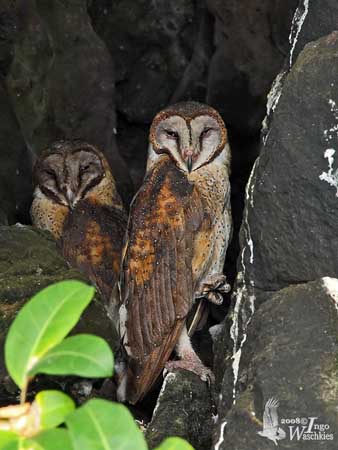
DIET:
The Sulawesi Masked Owl feeds on small vertebrates such as rats and shrews, and probably other types of preys.
It hunts by low flight over open areas or from perch, and by night.
PROTECTION / THREATS / STATUS:
The Sulawesi Masked Owl is widespread but usually uncommon in Sulawesi, and locally fairly common in Palu Valley. It is also present in Dumoba-Bone National Park.
The species is evaluated as Least Concern by Birdlife International.
Fr: Effraie des Célèbes
All : Sulawesieule
Esp: Lechuza de Célebes
Ital : Barbagianni di Rosenberg
Nd: Sulawesi-kerkuil
Sd: Sulawesitornuggla
Photographer:
Ingo Waschkies
Bird Photography
Text by Nicole Bouglouan
Sources:
HANDBOOK OF THE BIRDS OF THE WORLD Vol 5 by Josep del Hoyo-Andrew Elliott-Jordi Sargatal - Lynx Edicions - ISBN: 8487334253
OWLS OF THE WORLD – By Claus König, Friedhelm Weick and Jan-Hendrik Becking - IBSN 978-0-7136-6548-2
L’ENCYCLOPEDIE MONDIALE DES OISEAUX - Dr Christopher M. Perrins - BORDAS - ISBN: 2040185607
BirdLife International (BirdLife International)
Sulawesi Masked Owl
Tyto rosenbergii
Strigiforme Order – Tytonidae Family
BIOMETRICS:
Length: 43-46 cm
DESCRIPTION:
The Sulawesi Masked Owl is one of the largest members of the family Tytonidae. This species is endemic to Indonesia.
The adult male has dark blackish-grey upperparts, speckled and spotted white and pale chestnut areas on scapulars and upperwing-coverts. The flight feathers are dark brownish-grey with pale chestnut barring on secondaries.
On the underparts, breast, upper belly and flanks are pale buff with small blackish spots. Lower belly, vent, thighs and the feathered tarsi are creamy-white.
On the head, crown and nape are as upperparts. The facial disc is greyish-white, bordered by prominent reddish-brown rim making the heart-shaped face very sharp. It becomes slightly darker around the eyes.
The small, hooked bill is blackish. The eyes are dark brown. The powerful feet are pale pinkish-brown, equipped with long and curved black claws.

The female has similar plumage but she is darker than male. Her underparts are usually more heavily spotted, almost forming two bars.
The race T.r. pelengensis is smaller than nominate. This one has scaled effect on the breast, due to broken black feathers’ edges.
VOICE: SOUNDS BY XENO-CANTO
The Sulawesi Masked Owl gives short, hoarse calls “chreap”, also heard near the nest when the chicks are present. The juveniles gives repeated, loud, screaming hisses when they are begging food to adults.
The male’s song is a dry, creaky screech, an eerie sound of about one second and slightly wavering, ending in downward inflection “chreeochreoh” or “chreeeeho”. This sound can also be heard when the owl is hunting, or after dusk.
HABITAT:
The Sulawesi Masked Owl frequents cultivated areas with scattered trees, grasslands, open country with some tall dead trees, rainforest, and forest edge. It can be seen near villages and in urban areas.
This species occurs from sea-level up to 1100-1200 metres of elevation.
RANGE:
The Sulawesi Masked Owl is presumably sedentary in its range in Sulawesi and Sangihe Islands (T.r. rosenbergii) and Banggar Islands (T.r. pelengensis).

BEHAVIOUR:
The Sulawesi Masked Owl is a nocturnal owl. It feeds probably on small vertebrates such as rats and shrews, but according to the food resources, other preys can be taken.
It hunts over clearings and cultivated fields and at forest edges too.
It probably hunts in the same way that other Tytonidae species, either by dropping down onto the prey from a perch, or by low flight close to the ground, performing occasionally hovering and undulations.
This owl is very well adapted to the nocturnal hunting, even in the darkness, thanks to the soft “sound-damping” plumage, the asymmetrical ears and the large facial disc which collects the sounds waves. The long legs and the powerful claws allow the bird to catch its prey easily.
The breeding and nesting behaviours are unknown, but we can suggest that the male performs courtship feeding to the female. Chases occur between mates around the nest-site. The male calls more frequently.

FLIGHT:
The Sulawesi Masked Owl, as other Tytonidae species, has long, broad wings, allowing low wing-loading when hunting. It may hover before to drop down onto the prey.
These owls have silent flight which helps them to locate the preys when flying low from the ground.
REPRODUCTION:
There is no information about nesting and breeding behaviour of this species.
The masked owls are cavity nesters. Usually, the male feeds the female at nest during the incubation.
They lay much smaller clutches than typical Barn Owls. The incubation period varies according to the species. There are probably 2-3 eggs, and the incubation is evaluated at about 35-42 days, mainly by the female.
The chicks are covered in thick down. They are fed by both parents which deliver the preys at nest several times a day. The nesting period is usually fairly long, between 49 and 56 days.
